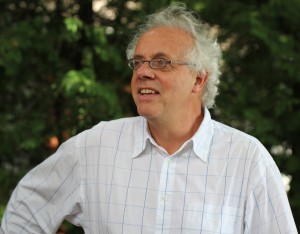 Tunisia, like all low and middle income countries, is having to respond to non-communicable disease after making good progress in reducing infectious disease and improving child and maternal health. Premature deaths from cardiovascular disease increased there by 35% between 1990 and 2010; they increased by 112% in Egypt and by 61% in Saudi Arabia—but fell by 21% in the United States. How best Tunisia might respond was discussed recently at a meeting in Sousse, organised by the Department of Epidemiology, University Hospital Farhat Hached.
Tunisia, like all low and middle income countries, is having to respond to non-communicable disease after making good progress in reducing infectious disease and improving child and maternal health. Premature deaths from cardiovascular disease increased there by 35% between 1990 and 2010; they increased by 112% in Egypt and by 61% in Saudi Arabia—but fell by 21% in the United States. How best Tunisia might respond was discussed recently at a meeting in Sousse, organised by the Department of Epidemiology, University Hospital Farhat Hached.
Tunisia doesn’t have to start with a blank sheet. High income countries have already experienced the transition from infectious to non-communicable disease, and the aspiration is that countries like Tunisia can learn from the successes of high income countries without having to repeat their mistakes.
Learning from Finland
One of the best countries to learn from is Finland, which back in the 1960s had the highest death rate in the world from cardiovascular disease. Professor Erkki Vartiainen, from the National Institute for Health and Welfare in Helsinki, explained how Finnish work began in the now famous North Karelia region, which had the highest death rate of all. (Karelia, a neighbouring region in Russia, still has very high rates, illustrating how public health action is essential.) The Finns worked through the community—schools, workplaces, neighbourhoods, health centres, and the media—with an emphasis on “structural changes,” such as improving school meals, redesigning transport systems, and working with the food industry to reduce the saturated fat and salt in their products. In other words, changes that don’t depend simply on individuals being “better behaved.”
The Finns working with communities constantly experimented with new ways to make healthy living the easy living. Many years ago they used reality television, with a show on six smokers trying to give up, akin to how we in Britain watch people trying to cook the perfect Bakewell tart or dance the paso doble. Evaluation of the Finnish programme showed that hundreds of thousands of people watched and 10 000 people managed to stop. The cost per QALY was probably almost as good as for a chiropodist, which has one of the lowest costs per QALY.
Deaths from heart disease have now fallen by 80% in Finland, with 60% of the decline the result of reduction in risk factors. Finns also feel healthier: in 1973 only 36% of people felt themselves to be in good health (a surprisingly low figure, I thought), now it’s much higher.
Learning from Iran
Professor Nizal Sarrafzadegan, a cardiologist from the Isfahan Cardiovascular Research Centre in Iran, described how they had run a programme—similar to that in North Karelia—in Isfahan between 2000 and 2006. This was a quasi-experimental programme with 6175 people in two intervention areas and 6339 in the reference (or control) area. Again there was a wide range of interventions in multiple sites, and the interventions were aimed at both populations and those at high risk. Sarrafzadegan emphasised that it was essential, not least for sustainability, for the community to own the programme, and over its six years the programme had 152 partners.
The programme had a huge number of outcome measures, and showed significant improvements in the intervention compared with the reference area in abdominal obesity, hypertension, and hypercholesterolaemia. Sarrafzadegan has also shown that death rates from heart disease and stroke in Isfahan, which were rising, are now falling. I asked her what had happened in the rest of Iran (remembering that death rates fell across Finland as well as in North Karelia), but she said that national data were not available.
Action in Tunisia
The Iranians have run many workshops on their programme, and Professor Hassen Ghannem from University Hospital Farhat Hached, who organised the meeting, attended those workshops. He and his team have now run a similar project in Sousse, measuring risk factors before and after a three year intervention programme, with around 4000 people in the intervention area and 4000 in the reference area. The team has worked with schools, workplaces, neighbourhoods, health centres, and the media and started with considerable political support.
Ghannem has, however, faced the challenge of running a research project when the country undergoes a revolution halfway through. He feared that it might all collapse, and local and national politicians have come and gone at remarkable speed. (I learnt that Tunisia has 69 candidates for president.) Luckily, people like teachers, doctors, and managers have stayed in place, and it has been possible to complete the project, only without some of the planned structural changes. Nevertheless, initial analyses show some improvements in risk factors.
Government responses
Enthusiasts for community programmes believe that the community is the best level at which to respond to NCD, but more is needed. Dr Slim Slama from the World Health Organization’s Eastern Mediterranean Regional Office (EMRO) described both the global and regional plans for responding to NCD. Famously, they require a “whole of government, whole of society” response with, for example, the government increasing tax on tobacco and banning smoking in public places, while the health system ensures the direction and treatment of all those at high risk for cardiovascular disease. WHO has set a target of reducing the deaths of those under 70 from NCD by 25% by 2025 and is now urging each country to set its own targets. This is not easy in many low and middle income countries as basic data on mortality and risk factors are either lacking or unreliable.
Dr Rafla Tej Dallagi, director of primary care at the Tunisian Ministry of Health described how the ministry is responding to NCD, and, unsurprisingly, much of the response might be summarised in these early days as “plans rather than practice.” I presented preliminary results from a study we are doing of how well 23 countries, most of them low and middle income countries, are doing in responding to NCD. Through a Delphi process we have identified 51 indicators. We have then asked people from government, non-governmental organisations, academia, and the private sector in each country how that country is doing in responding to NCD. We have hypothesised that government respondents might give more favourable responses than those from other sectors. Our preliminary high level results suggest that Tunisia is doing moderately well in its health sector response and poorly on governance, risk factors, and surveillance and research.
These results are unsurprising as Tunisia, like most low and middle income countries, is at the beginning of what will have to be a long term response to NCD. It will be interesting to see how quickly and effectively Tunisia can respond, and how much it relies on community level interventions.
Richard Smith was the editor of The BMJ until 2004. He is now chair of the board of trustees of icddr,b [formerly International Centre for Diarrhoeal Disease Research, Bangladesh], and chair of the board of Patients Know Best. He is also a trustee of C3 Collaborating for Health.
Competing interest: RS is the director of the UnitedHealth Chronic Disease Initiative, which has funded the research in Tunisia and at least in part the meeting. He spoke at the meeting, and the UnitedHealth Foundation has funded the work he presented.
